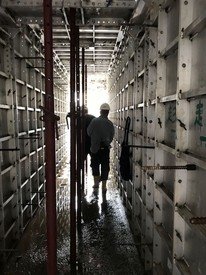Digital Construction: A Better Way to Build
The RFID-BIM platform developed by Dr Wilson Lu’s team enabled everyone in the building process, from manufacturer to transporter to contractor, to see where each component was at all times, which resulted in shorter production cycle for manufacturing
The shortage of housing is often cited as Hong Kong’s most pressing problem so there is a lot of interest in getting new units built more quickly and efficiently. A cross-disciplinary team of scholars has come up with a solution that saves valuable time and makes the operations more transparent.
Their system combines two types of technology, radio-frequency identification (RFID) and building information modelling (BIM), to tag pre-fabricated building components and monitor their progress throughout the production, transportation, and assembly process. No more guesswork is needed about when to procure new components, and no more mistakes slip through, such as forgetting to order components which can cause lengthy delays.
The system was developed in a collaboration between engineering and architecture scholars at HKU and Hong Kong Polytechnic University.
They unveiled their system in 2014 and quickly attracted attention from the Housing Authority, which provided a site in Tuen Mun to test out its application in pre-fab housing manufactured in Guangdong then shipped to Hong Kong for assembly. The Innovation and Technology Fund provided funding, and industry partners also became involved.
The RFID-BIM platform they developed enabled everyone in the building process, from manufacturer to transporter to contractor, to see where each component was at all times because the RFID tag uploaded location data using a global positioning system. “This meant there was real-time information, traceability and visibility,” said Dr Wilson WS Lu of the HKU Department of Real Estate and Construction.
The resulting improvements in communication and efficiency meant the production cycle for manufacturing prefabricated components decreased to six days and the accuracy of on-site assembly increased from 99.85 per cent to 100 per cent – a potentially significant saving given the large scale of public housing construction in Hong Kong.
Moreover, less time was required for checking the on-site availability of prefabricated components, the quality of work could be tracked at each stage, and the system could respond quickly to design and order changes and to repairing defective components. There were even paper savings because less paperwork was required.
The project has solidified the team’s ties with the Housing Authority and construction industry representatives and firms in Hong Kong and Shenzhen. It has also attracted attention from experts at the University of Florida, who have visited to learn more about the unique blending of RFID and BIM technologies, and from the Housing Society, which has commissioned the team to test their platform at a site in Tseung Kwan O. “We hope the private sector will start using it too,” Dr Lu added.
Dr Wilson WS Lu of the Department of Real Estate and Construction and his team members, Professor Guo Quan Huang of the Department of Industrial and Manufacturing Systems Engineering and Professor Thomas Shiu Tong Ng of the Department of Civil Engineering, received the Faculty Knowledge Exchange Award 2018 of the Faculty of Architecture for the project ‘RFID-Enabled Building Information Modeling (BIM) Platform for Prefabrication Housing Production in Hong Kong’.




